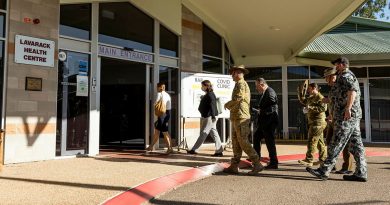Hornets farewelled after more than 35 years of service
Share the post "Hornets farewelled after more than 35 years of service"

Air Force has farewelled the F/A-18A/B Hornets after more than 35 years of service, with an end of era event at RAAF Base Williamtown on November 29.
CAPTION: Aircraft A21-02 flown by Group Captain Jason Easthope, Chief of Staff, Air Combat Group puts on the last handling display for a RAAF F/A-18 Hornet at RAAF Base Williamtown. Story by Flight Lieutenant Jessica Aldred. Photo by Corporal Craig Barrett.
In a fitting tribute to the jet, a solo flying display marked its final farewell to the Australian public at the Wings over Illawarra Airshow on November 28.
The first two F/A-18A/B Hornets arrived in Australia on June 6, 1984, partially disassembled in the back of a C-5 Galaxy all the way from St. Louis, Missouri, United States. They were followed by the next two Hornets, flown in a non-stop record-breaking trans-Pacific 15-hour ferry on May 17, 1985.
Over the next 3 decades, 71 Hornets contributed to multiple operations and exercises through the dedication of all aviators at Nos. 3, 75 and 77 Squadron, and No. 2 Operational Conversion Unit.
CAPTION: Group Captain Jason Easthope returns from his display at the Classic Hornet end of an era celebration at RAAF Williamtown, New South Wales. Photo by Leading Aircraftwoman Catherine Kelly.
Commander Air Combat Group, Air Commodore Tim Alsop, said the farewell activity included a flying display over Tindal and Williamtown to thank the community for their support.
“We could not conduct our flying operations and exercises without the support of the community, particularly around RAAF Bases Tindal, Williamtown and Darwin – they have supported us for the last 30 years and for that we thank them,” Air Commodore Alsop said.
“The Hornets have contributed to Australia’s air power for one third of Air Force’s centenary, protecting Australia and its interests both at home and on the world stage.
“Whilst pilots are critical to fly a Hornet, it’s a team effort to keep them in the air – with technicians, engineers, logistics, life support fitters, personnel capability and security forces all ensuring that the Hornet could conduct its role.”
The F/A-18A (single seat) and F/A-18B (twin seat) Hornets have been an integral part of Australia’s air combat capability, capable of air-to-air and air-to-ground missions.
The F/A-18A/B Hornets deployed to Operations Slipper, Falconer and Okra conducting strike and close air support missions in support of coalition forces.
CAPTION: Group Captain Jason Easthope is congratulated by The Hon Peter Dutton MP, Minister for Defence, along with Chief of Air Force, Air Marshal Mel Hupfeld, AO, DSC, after the last aerial handling display for a RAAF F/A-18A/B Hornet at RAAF Base Williamtown, New South Wales. Photo by Corporal Craig Barrett.
Chief of Staff Air Combat Group, Group Captain Jason Easthope, said the Hornet was a capable aircraft that served Air Force with distinction.
“For the last 20 years, the Hornets have served on multiple operations overseas and at home, including our contribution to strike missions on Operations Falconer and Okra – this was significant as Australia had not dropped bombs in combat since the Vietnam War,” Group Captain Easthope said.
“On Operation Okra, F/A-18A/B Hornet squadrons flew 1937 missions and more than 14,780 flying hours, delivering approximately 1,600 munitions.
“Flying is my passion and I will always have a soft spot for the Hornet.”
The end of Hornet operations for No. 75 Squadron marks the beginning of a new chapter, as the Air Force transitions to the F-35A Lightning II.
.
.

.
.
Share the post "Hornets farewelled after more than 35 years of service"








What is happening to the planes now, are they sold, if so to whom?
What is happening to the planes now, are they sold, if so to whom?
RAAF is doing great work; have kept well up to date with new technology, have planned their upgrades with precision and they regularly demonstrate their professionalism, skill, flair and determination.
To be true, they have had good budget coverage and have enjoyed great funding support from Government.
They will play a vital and distinctive role in any future conflict.
But they now need about 2 x squadrons of strategic long range bombers to replace the F-111 capability that was retired over 11 years ago and to supplement the F-35s with longer range combat capabilities with something like an F-15EX. Again 2 x squadrons would be another huge 5th Generation step forward for the RAAF.
Lots of practice over long ranges (including overseas deployments) carrying and firing long range missiles would also be expensive but useful. Vital also to heavily protect every one of their/our most valuable assets.
Very proud of what this wonderful group of Australians have achieved and continue to achieve each day.
Per Ardua Et Astra!